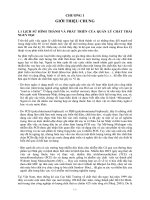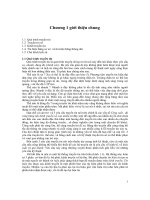- Trang chủ >>
- Sư phạm >>
- Sư phạm sinh
Slide hệ phân bố chương 1 giới thiệu chung
Bạn đang xem bản rút gọn của tài liệu. Xem và tải ngay bản đầy đủ của tài liệu tại đây (564.26 KB, 23 trang )
Distributed Systems
Thoai Nam
Faculty of Computer Science and Engineering
HCMC University of Technology
CuuDuongThanCong.com
/>
References
1.
George Coulouris, Jean Dillimore, Tim Kindberg,
Distributed Systems: Concepts and Design,
Addison-Wesley, 2000.
2.
Andrew S. Tanenbaum, Distributed Operating
Systems, Prentice Hall, 1990.
3.
Nancy Lynch, Distributed Algorithms, Morgan
Kaufmann, 1997.
CuuDuongThanCong.com
/>
Khoa Công Nghệ Thông Tin – Đại Học Baùch Khoa Tp.HCM
Syllabus
Chương
Nội dung
Khối lượng
TS LT (BT) (TH,TN) (TL)
Tài liệu
tham khảo
1
Giới thiệu Hệ phân bố
2
1, 2
2
Giao tiếp giữa các quá trình
2
1, 2
3
Dịch vụ File
2
1,2
4
Dịch vụ tên
2
1,2
5
Thời gian và vấn đề đồng bộ
2
1,2
6
Bảo mật
1 (Self-study)
7
Giải thuật phân bố
3 (Self-study)
8
Định thời biểu cho chương
trình
9
Ôn taäp
CuuDuongThanCong.com
1,2 (Self-study)
3
/>
Chapter 1: Introduction
Distributed Systems
Hardware & software
Transparency
Scalability
Distributed OS
CuuDuongThanCong.com
/>
Khoa Khoa học và Kỹ thuật Máy tính – ĐHBK TP.HCM
Definition of a Distributed System
What is a distributed system?
– Multiple connected CPUs working together
– A collection of independent computers that appears to its users as a
single coherent system [Tanenbaum]
– One in which components located at networked computers
communicate and coordinate their actions by only message passing
[Coulouris]. Tập hợp máy tính giao tiếp với nhau thông qua cơ chế truyền thông điệp.
—> Lý thuyết ban đầu, nhưng khi hiện thực khó khăn.
CuuDuongThanCong.com
/>
Khoa Khoa học và Kỹ thuật Máy tính – ĐHBK TP.HCM
Examples of Distributed Systems
Parallel machines, networked machines
Cluster: “A type of parallel or distributed processing system, which
consists of a collection of interconnected stand-alone computers
cooperatively working together as a single, integrated computing resource”
[Buyya]
Grid: “A type of parallel and distributed system that enables the sharing,
selection, and aggregation of geographically distributed autonomous
resources dynamically at runtime depending on their availability,
capability, performance, cost, and users' quality-of-service requirements”
[Buyya] 3 vấn đề: ảo hoá, pay-as-use, scalable (eslastic)
Cloud: “A Cloud is a type of parallel and distributed system consisting of a
collection of interconnected and virtualized computers that are
dynamically provisioned and presented as one or more unified computing
resources based on service-level agreements established through
negotiation between the service provider and consumers” [Buyya]
CuuDuongThanCong.com
/>
Khoa Khoa học và Kỹ thuật Máy tính – ĐHBK TP.HCM
Advantages and Disadvantages
Advantages
–
–
–
–
Communication and resource sharing possible
Economics – price-performance ratio
Reliability, scalability
Potential for incremental growth
Disadvantages
– Distribution-aware PLs, OSs and applications
– Network connectivity essential
– Security and privacy
CuuDuongThanCong.com
/>
Khoa Khoa học và Kỹ thuật Máy tính – ĐHBK TP.HCM
(thi)
Transparency in a Distributed System
Transparency
Description
Access
Hide differences in data representation and how a resource is
accessed
Location
Hide where a resource is located
Migration
Hide that a resource may move to another location
Relocation
Hide that a resource may be moved to another location while in
use
Replication
Hide that a resource may have many copies
Concurrency
Hide that a resource may be shared by several competitive users
Failure
Hide the failure and recovery of a resource
Persistence
Hide whether a (software) resource is in memory or on disk
Different forms of transparency in a distributed system.
CuuDuongThanCong.com
/>
Khoa Khoa học và Kỹ thuật Máy tính – ĐHBK TP.HCM
Scalability Problems
Concept
Example
Centralized services
A single server for all users
Centralized data
A single on-line telephone book
Centralized algorithms
Doing routing based on complete
information
Giải thuật tập trung:
Giải thuật phân bố: mỗi phần, giải quyết bằng cách ghép các phần lại.
Examples of scalability limitations
CuuDuongThanCong.com
/>
Khoa Khoa học và Kỹ thuật Máy tính – ĐHBK TP.HCM
Hardware Concepts: Multiprocessors (1)
Multiprocessor dimensions
– Memory: could be shared or be private to each CPU
– Interconnect: could be shared (bus-based) or switched
A bus-based multiprocessor.
CuuDuongThanCong.com
/>
Khoa Khoa học và Kỹ thuật Máy tính – ĐHBK TP.HCM
Multiprocessors (2)
a)
A crossbar switch
b) An omega switching network
1.8
CuuDuongThanCong.com
/>
Khoa Khoa học và Kỹ thuật Máy tính – ĐHBK TP.HCM
Homogeneous Multicomputer Systems
a)
Grid
b) Hypercube
1-9
CuuDuongThanCong.com
/>
Khoa Khoa học và Kỹ thuật Máy tính – ĐHBK TP.HCM
Distributed Systems Models
Minicomputer model
(Server tầm trung)
– Each user has local machine
– Local processing but can fetch remote data (files, databases)
Workstation model
(PC)
– Processing can also migrate
Client-server Model
– User has local workstation
– Powerful workstations serve as servers (file, print, DB servers)
Processor pool model
– Terminals are Xterms or diskless terminals
– Pool of backend processors handle processing
CuuDuongThanCong.com
/>
Khoa Khoa học và Kỹ thuật Máy tính – ĐHBK TP.HCM
Uniprocessor Operating Systems
An OS acts as a resource manager or an
arbitrator
– Manages CPU, I/O devices, memory
OS provides a virtual interface that is easier to
use than hardware
Structure of uniprocessor operating systems
– Monolithic (e.g., MS-DOS, early UNIX)
» One large kernel that handles everything
– Layered design
» Functionality is decomposed into N layers
» Each layer uses services of layer N-1 and
implements new service(s) for layer N+1
CuuDuongThanCong.com
/>
Khoa Khoa học và Kỹ thuật Máy tính – ĐHBK TP.HCM
Uniprocessor Operating Systems
Microkernel architecture
Small kernel
User-level servers implement additional functionality
CuuDuongThanCong.com
/>
Khoa Khoa học và Kỹ thuật Máy tính – ĐHBK TP.HCM
Distributed Operating System
Manages resources in a distributed system
– Seamlessly and transparently to the user
Looks to the user like a centralized OS
– But operates on multiple independent CPUs
Provides transparency
– Location, migration, concurrency, replication,…
Presents users with a virtual uniprocessor
CuuDuongThanCong.com
/>
Khoa Khoa học và Kỹ thuật Máy tính – ĐHBK TP.HCM
Types of Distributed OSs
System
Description
Main Goal
DOS
Tightly-coupled operating system for
multi-processors and homogeneous
multicomputers
Hide and
manage
hardware
resources
NOS
Loosely-coupled operating system for
heterogeneous multicomputers (LAN and
WAN)
Offer local
services to
remote clients
Middleware
Additional layer atop of NOS
implementing general-purpose services
Provide
distribution
transparency
CuuDuongThanCong.com
/>
Khoa Khoa học và Kỹ thuật Máy tính – ĐHBK TP.HCM
Multiprocessor Operating Systems
Like a uniprocessor operating system
Manages multiple CPUs transparently to the user
Each processor has its own hardware cache
– Maintain consistency of cached data
CuuDuongThanCong.com
/>
Khoa Khoa học và Kỹ thuật Máy tính – ĐHBK TP.HCM
Multicomputer Operating Systems
1.14
CuuDuongThanCong.com
/>
Khoa Khoa học và Kỹ thuật Máy tính – ĐHBK TP.HCM
Network Operating System (1)
1-19
CuuDuongThanCong.com
/>
Khoa Khoa học và Kỹ thuật Máy tính – ĐHBK TP.HCM
Network Operating System (2)
Employs a client-server model
– Minimal OS kernel
– Additional functionality as user processes
1-20
CuuDuongThanCong.com
/>
Khoa Khoa học và Kỹ thuật Máy tính – ĐHBK TP.HCM
Middleware-based Systems
General structure of a distributed system as middleware.
1-22
CuuDuongThanCong.com
/>
Khoa Khoa học và Kỹ thuật Máy tính – ĐHBK TP.HCM
Comparison between Systems
Distributed OS
Multiproc. Multicomp.
Network
OS
Middlewarebased OS
Degree of transparency
Very High
High
Low
High
Same OS on all nodes
Yes
Yes
No
No
Number of copies of OS
1
N
N
N
Basis for communication
Shared
memory
Messages
Files
Model specific
Resource management
Global,
central
Global,
distributed
Per node
Per node
Scalability
No
Moderately
Yes
Varies
Openness
Closed
Closed
Open
Open
Item
CuuDuongThanCong.com
/>
Khoa Khoa học và Kỹ thuật Máy tính – ĐHBK TP.HCM









